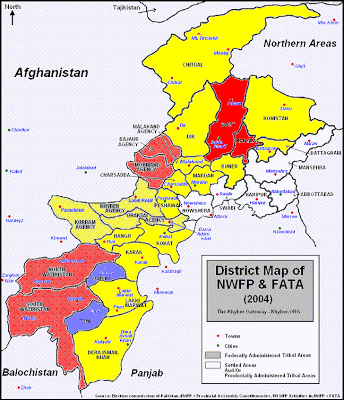The Pakistani military parachuted soldiers Tuesday into Buner, in the Malakand district of the North-West Frontier Province, to take on the estimated 500 militants who had made a bid to take over Buner. From all accounts, the Pakistani government of Asaf Ali Zardari does not think what happens in Buner is actually very important. But the Obama administration, alarmed at the spread of the Pakistani Taliban further into Malakand (which borders Afghanistan and so has security implications for US & NATO troops) has pressured Islamabad to intervene. LAT quotes former interior minister Tasnim Noorani to the effect that the Pakistani government will actually have to rule in Malakand if it is to succeed, since surgical military operations are unlikely to have a long-term success.
On Wednesday morning, it was announced that the Pakistani military had taken control of Dagar, the capital of Buner district. Fighting remained heavy in the area, with 70 militants claimed killed and another 350 or so still holding out in parts of the district.
The operation in Buner was launched after Pakistani intelligence intercepted a telephone call between Pakistani Taliban leader Mawlana Fazlullah and one of his commanders indicating that their plan was to feign a withdrawal from Buner and then to launch a surprise takeover. The Tehrik-i Taliban-i Pakistan (TTP) stands accused of killing or kidnapping local NWFP security personnel and kidnapping adolescent boys from villages for induction into the TTP paramilitary.
High Obama administration officials appear to have worked themselves into a frenzy about events in Malakand, and propose dealing with it by giving Islamabad more money more quickly than planned and also training Pakistani troops in counter-insurgency. Some US officials suspect duplicity on the part of the government of Pakistani President Asaf Ali Zardari. I take it that means they think the Pakistani military is sanguine about the spread of Talibanism in Malakand because the Pakistani Taliban might be useful in projecting Pakistani influence in the southern Pushtun areas of Afghanistan, which Islamabad considers its “strategic depth.”
One of the reasons for which the Pakistani government has been unwilling to conduct major military operations against the militants in Swat Valley and Buner may be the risk of massive population displacement, which in turn could be more destabilizing than a few Taliban. Even in the fighting in the past few days to push the Pakistani Taliban out of parts of Malakand, 30,000 civilians were displaced from their homes. Some 300,000 were displaced by the Bajaur campaign last fall and into winter 2009. And altogether the UNO is estimating that 600,000 are now displaced by fighting in the Federally Administered Tribal Areas and the North-West Frontier Province (and are so destitute that they need food aid), and Pakistani authorities believe it may be as much as a million. There are only 3.5 million persons in the Federally Administered Tribal Areas, and another say 17 million in the NWFP. My guess is that a good ten to fifteen percent of all the inhabitants of FATA are now internally displaced persons and many seem to be vulnerable.
The insecurity in the FATA areas is badly affecting the nearby capital of the North-West Frontier Province, Peshawar, which has seen militant attacks on its infrastructure and where the population now rushes home at nightfall.
The connection between the Pakistani Taliban advance in Malakand areas like Dir and the security of US troops fighting next door in the Kunar Province of Afghanistan is underlined by this CBS video:
Riz Khan covers the rise of the Pakistan Taliban in the North-West, noting that British PM Gordon Brown recently expressed anxiety that Pakistani Talibanism forms a threat to the security of London.
End/ (Not Continued)




 © 2025 All Rights Reserved
© 2025 All Rights Reserved